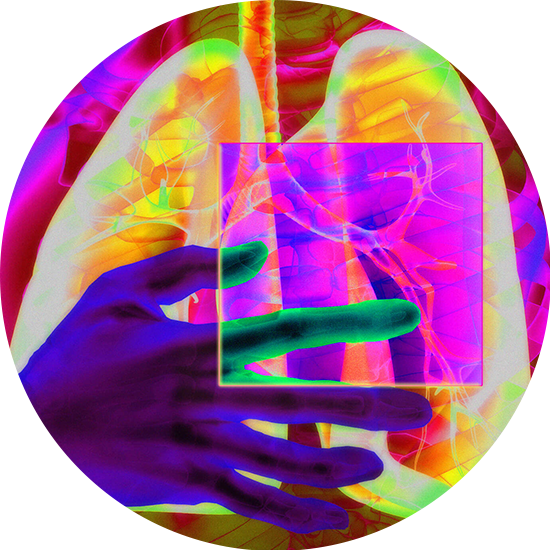
Airway Clearance
“Out, damned spot! out, I say!” – Lady Macbeth
Written with gratitude to my Co-Author, Marion Mackles, BS, PT, LMT
Everyone has mucus. It is one of the many defense mechanisms in our body’s arsenal that protect us against infection and other un-pleasantries. In fact, if Lady Macbeth were a chest physiotherapist, she may well have been known for another quote: “Out, damned snot!” Before we discuss how to minimize and mobilize the secretions (mucus) that may accumulate in your airways as a result of your disease, it will be helpful for you to have a basic knowledge of what mucus actually is and what mucus actually does.
Take a breath in through your nose. Congratulations! You have just inhaled a small sample of the many thousands of tiny organisms and a varied array of particulate matter that we breathe in each and every day. When we breathe in through the nose, the air goes through its first warming, filtering, and humidifying process. If you are a mouth breather, the respiratory tissues will have to handle the job on their own, further down the respiratory tract.
The mucous (different than mucus) tissues or membranes that line the nasal cavity have a sticky surface that helps trap debris, like flypaper. There are also tiny hair-like structures called cilia that help move the air and mucus through the sinus cavity to prepare it for its journey into the lungs, the GI tract; or to be expectorated. Our airways and lungs perform a similar filtration process as air passes through them. This filtration system is called the “mucociliary escalator,” or “mucociliary transport system.”
The Airway Swamp
The airways leading into the lungs are lined with epithelial cells that protect the airways and lungs. These cells are loosely square-shaped and have thousands of cilia. Scattered throughout the epithelial cells are mucus-producing goblet cells. This is where I start to draw a picture in my mind of a swamp. The cilia float in a thin mucous fluid that is slightly thicker than water and a thick layer of mucus that rests on top of the cilia. That’s the stuff that traps debris; which I like to picture as bugs in the swamp; that are stuck to the top scummy layer.
Under all of that, we have clear, crisp water in which our cilia (swamp plants) move back and forth in a wave-like motion. This wave-like motion pushes the mucus up through the airways, millimeter by millimeter to the throat, where it is either swallowed or expectorated (coughed out). If it is swallowed, the stomach acids destroy any organisms that may be living in the mucus. In addition, to swallowing or expectorating, some smaller particles of mucus are expelled as vapor when we exhale. This process automatically takes place every second of every day, whether we have a pulmonary condition or not.
Just like the ecosystem of a swamp, any alien intruder or other irritant can throw this well-coordinated system out of balance. In response, the goblet cells start overproducing mucus to help fight whatever irritant or foreign invader may be present. In addition, goblet cells from the lower layers can break through to the upper layer, overpowering the ciliated epithelial cells. At this point, we lose the wave action of the cilia, and the sluggish goblet cells take over the swamp. This delicate transport system can also be affected by other factors like scar tissue or paralyzed cilia (from cigarette smoking or exposure to environmental toxins), temperature, and humidity.
AIRWAY CLEARANCE TECHNIQUES
When it comes to airway clearance techniques, patients often ask, “which method works the best?” and the answer is always the same: “it depends on the individual.” Every person is at least slightly different with respect to his or her anatomy and physiology, disease process and progression, level of conditioning, lifestyle, etcetera, and etcetera. For that reason, it will often take some trial and error to figure out what will work best for you, but at some point, you have to take the first step. Starting somewhere and doing something is always better than doing nothing!
When it comes to the techniques themselves, you have many options available to you, including the many devices on the market such as positive expiratory pressure (PEP) devices, oscillating PEP devices, valves that alter sound wave frequencies, and vests, among others. There are also manual chest therapy techniques that require a second person to assist you. However, before we get to those, let’s talk about some of the techniques you can do on your own and without spending a penny. These techniques can be used on their own or in tandem with one of the various devices to make the treatment even more effective.
I usually recommend performing the airway clearance techniques two to three times per day. The most important (and effective) times are in the morning, shortly after you wake up and in the evening about an hour or so before going to bed, not immediately before bed. Sometimes, it can take a while for the mucus to come up and we don’t want your sleep to be disturbed by coughing. Many of the positions people sleep in are also natural drainage positions (which we will discuss later). Did you ever notice that when you wake up in the morning, one of the first things you do is clear your throat, cough, or even hack up some sputum? This is the perfect time to take advantage of Mother Nature by using one of the clearance techniques for maximum benefit.
In the evening, you want to clear out your lungs of whatever may have accumulated during the day. These times can also be coordinated with your medications. Some techniques work well 5–15 minutes after taking your bronchodilator. Vests and some of the other devices can be used while nebulizing to help the medications go deeper into the lungs. But, before we get too far ahead of ourselves, let’s look at the techniques.
Active Cycle of Breathing Technique (ACBT)
The Active Cycle of Breathing (ACBT) consists of a series of different breathing patterns that help loosen and mobilize mucus for expectoration; i.e. huffing, coughing, or in some cases, “hacking out” the mucus. ACBT requires no equipment and can either be performed sitting in a chair or in one of the postural drainage positions. For most sessions, I prefer not to have patients leaning back in the chair. When you lean back and rest on a surface, you are inhibiting ribcage movement and airflow to that part of the lungs. Instead, sit straight up with your feet flat on the floor. Please check with your physician before trying these techniques and if possible, schedule a session with a chest physical therapist or health professional trained in ACBT. If this is not possible, begin your practice slowly with the basic cycle.
Breathing Control or Relaxed Breathing (1 minute)
Settle into a relaxed, gentle, pattern of breathing in through the nose and exhaling quietly (not forced) through pursed lips, although some people teach this with an open mouth. If you have difficulty breathing in through your nose, breathe in through pursed lips. This step will relax the airways and accessory muscles and can also help alleviate anxiety. Breathing control should always be done before a huff (more on this in a moment).
Deep Breathing or Thoracic Expansion (3–5 breaths)
While taking a slow, deep, breath in, expand your lower ribs, allowing air to fill your chest. Don’t force it! You may want to do this in front of a mirror placing your hands on your lower ribs when you are first learning this technique. Once your lungs are full, hold your breath for 2–3 seconds. If you are uncomfortable with breath holding (or prone to pneumothorax), you can skip this step. Then, sigh your breath out through pursed lips, allowing your ribcage to deflate slowly, like an accordion.
Huffing or Forced Exhalation (1–3 breaths)
Huffs are a form of forced exhalation. To do this, open your mouth wide with a relaxed dropped jaw. Imagine that you are trying to steam up your glasses before you clean them.
The basic pattern is ABAC, which equals one cycle:
- Breathing Control or Relaxed Breathing (1 minute)
- Deep Breathing or Thoracic Expansion (3–5 breaths)
- Breathing Control or Relaxed Breathing (1 minute)
- Huffing or Forced Exhalation (1–3 breaths)
I recommend repeating the cycle until you have expectorated, but no more than 3 times so you don’t wear yourself out. Often, a patient will become very productive about a half hour to an hour after ACBT.
There are two different types of huffs:
C1: Lower Airway Huff:
Take a small to medium breath in and give an extended huff out. The lower airway huff clears secretions from your lower airways.
C2: Upper Airway Huff:
Take a long, slow, deep breath in and give a quick huff out. The upper airway huff clears secretions from your upper airways.
If you choose to do both types of huffing, separate them by 1 minute of Breathing Control in between. Depending on your ability, or what works best for you, the cycle can be extended (e.g. ABABAC1). You can also perform several cycles (e.g. ABAC1/ABAC2/ABAC1). In this case, the pattern would be:
Cycle 1:
- Breathing Control or Relaxed Breathing (1 minute)
- Deep Breathing or Thoracic Expansion (3–5 breaths)
- Breathing Control or Relaxed Breathing (1 minute)
C1. Lower Airway Huff (1–3 breaths)
Cycle 2:
- Breathing Control or Relaxed Breathing (1 minute)
- Deep Breathing or Thoracic Expansion (3–5 breaths)
- Breathing Control or Relaxed Breathing (1 minute)
C2. Upper Airway Huff (1–3 breaths)
Cycle 3:
- Breathing Control or Relaxed Breathing (1 minute)
- Deep Breathing or Thoracic Expansion (3–5 breaths)
- Breathing Control or Relaxed Breathing (1 minute)
C1. Lower Airway Huff (1–3 breaths)
Depending on the therapist, there may be slight variations in the methods and techniques used. However, as always, the individual protocols should be adapted to match the needs and abilities of the patient.
Controlled Cough
I like my patients to complete every chest clearance session with a 3-tier controlled cough. We are not talking about hard, forceful coughs that tighten the throat and irritate the tissues. When done properly, coughing is one of the most effective clearance tools.
Sit with your feet flat on the floor, shoulder-width apart. Place both hands on your abdomen, pressing slightly inward like a girdle. Take a slow, deep breath in through your nose and hold for 2–3 seconds. Then, bending forward, simultaneously give 3 small, short, staccato-type coughs in a single breath while continuing to apply pressure to your abdomen. If you need to repeat this process, perform 1 minute of breathing control/relaxed breathing before continuing.
Splinted Cough
If you need more support, you can wrap your arms around your abdomen or hug a pillow or towel. This is particularly helpful following thoracic or abdominal surgery. If this is the case, place the pillow or towel over the incision site and squeeze for added support and to reduce pain. This is also effective for anyone who might have musculoskeletal or orthopedic issues or osteoporosis that might be prone to spontaneous rib fractures, including people who have been on steroids for prolonged periods or at a high dosage.
Postural Drainage
Postural drainage consists of 12 different positions that use gravity to help mucus drain from the various lung segments into the larger airways, where it can be expectorated. I recommend holding each position for 5–15 minutes; and some specialists recommend even longer. Like everything else, you just have to try it and learn what works best for you. Some people need to incorporate all the positions into their daily routine, while others only need to use one or two regularly.
Many patients benefit from leaning over a table while sitting or standing, performing deep breathing exercises. Some hang over their beds; or use a tub chair or bench. Sitting in the shower, they lean forward while splinting their arms on their legs or on the wall in front of them, while doing deep breathing or ACBT. Many people find that the steam from the shower helps loosen their secretions, making it easier for them to expectorate.
Postural drainage techniques are best done with ACBT. Many patients also use PEP devices to loosen the mucus even more while in these positions. Some people benefit from taking their bronchodilator 5–15 minutes before postural drainage and any nebulized steroids or antibiotics about 30 minutes to an hour after postural drainage.
NOTE: Do not eat for an hour before your postural drainage treatment.
In addition to the drainage positions alone, healthcare professionals can also use percussion (or cupping), vibration, and shaking when performing chest therapy and teach these techniques to family members or caregivers. In some positions, the patient can percuss himself/herself or use a small handheld vibrator. You can also buy handheld cupping devices that are specifically designed for chest therapy (not musculoskeletal treatments). As always, please find a trained health care professional to teach you and your caregivers the proper techniques and adaptations to suit your particular situation.
Percussion (Cupping)
Contrary to what some of you may have experienced, percussion or cupping does not involve hitting or slapping the hell out of somebody with an open hand. When done properly, this technique should not be painful at all. To perform cupping, gently cup your hand, clapping the chest wall in a rhythmic pattern, alternating hands. Instead of a slap, you should hear a hollow, popping sound and feel the flow of air passing between your hands. To protect the skin, the patient should wear a thin layer of clothing like a t-shirt or hospital gown. Keep in mind that you are not trying to bang the mucus out. What you are doing is vibrating air molecules to shake the mucus loose.
Vibration
Vibration involves placing a flat hand firmly over the focal area; typically over the ribcage. Keeping your own trunk stable, stiffen your arm and hand, causing it to shake. The patient should take deep breaths in through the nose and out through the mouth, with vibration being performed during exhalation. This technique along with cupping is extremely effective in helping to mobilize secretions.
Always end your sessions with some good deep breaths and controlled coughing (or huffs, or both). Again, please check with your doctor before beginning any chest therapy program, especially if you have any musculoskeletal or orthopedic issues, cardiovascular conditions, GERD (acid reflux/acid stomach), or hemoptysis (blood in your sputum).
Now that we have covered treatments you can do at home, mostly without help, and without purchasing anything, let’s move on to the world of valves and other gizmos aka airway clearance devices.
Airway Clearance Devices
Incentive Spirometer (IS)
Many people ask about the incentive spirometer and may even have one hanging around from a previous hospital stay, particularly, following a thoracic, abdominal or other surgical procedure. These plastic devices use plastic balls or a plunger-type indicator to provide a patient with visual feedback for inhaled airflow and volume. Using this device can help prevent atelectasis, pneumonia, and other pulmonary complications caused by prolonged bedrest, anesthesia, and/or pain medications. An incentive spirometer helps to clear secretions by visually cueing a person to take in a greater volume of air, opening up the lungs more fully.
Some of our patients find that using an incentive spirometer helps them to take a few deeper breaths either prior to postural drainage or at the end, before performing a controlled cough. Anything that helps you take a deeper breath or mobilize secretions is a good thing!
The incentive spirometer comes with a list of settings of normal volumes based on age and gender. Start with a setting that is just slightly above the highest amount that you can currently perform, gradually increasing the volume as your lungs improve. We instruct our patients to take a slow, deep breath in through the nose and gently blow out through pursed lips. Then put the mouthpiece in your mouth with a tight seal and slowly inhale. When you get to your peak, hold the breath for 1–3 seconds and then let the air out gently. Some clinicians will ask you to blow the air out into the apparatus. I ask my patients to take the mouthpiece out and exhale through pursed lips.
Usually, people are instructed to repeat the process 10 times in a single sitting, but patients often start to fatigue their diaphragm, making this an exercise in futility. Instead, repeating only 3 cycles at a time, allows you to focus on the process, slowing things down and making it more effective, without becoming exhausted. The first time allows you to get a feel for the exercise, the second lets you make any necessary adaptations, and the third time is for the win! However, do not stress too much about performing an exact number of breaths or exhaling with or without the mouthpiece. Instead, try to focus on properly executing the inhalation through the mouthpiece. Always end your sessions with some deep breathing and controlled coughing (or huffs, or both).
POSITIVE EXPIRATORY PRESSURE VALVE
The PEP (Positive Expiratory Pressure) valve is not used as often but has been around since the 1970s. Once the oscillatory PEP valves (Flutter, Acapella) became available in the 1990s, many doctors, therapists, and patients switched over. On a PEP valve, you take a deep, full breath and exhale slowly through the mouthpiece. When blowing out, the device’s resistance pressure (between 10–20 cm H2O) helps splint open the airways. This allows more air to move along the airways below the mucus to move it into the larger bronchi. Most of these devices have a manometer to ensure you are creating the right amount of pressure.
Once again, start in a comfortable seated position. Using your ACBT, perform 1 minute of breathing control relaxed breathing. This time, replace the deep breathing portion with 10 inhalations and exhalations through the PEP. Continue to follow your ACBT while substituting the deep breathing portion with the PEP device. To visualize this method, I like to think about the air flowing down the sides of airways, speeding by trapped cloud-like shapes of mucus. Then, I picture the air reaching a bulb-shaped bottom where it whips around for a high-speed return trip up the center of the airways, pushing the mucus up with it. Please note that as with all of the PEP devices, make sure that you are not puffing your cheeks, which will diminish the effects. If you find that you do tend to puff your cheeks, use one hand to hold them while exhaling.
While positive expiratory pressure makes mucus clearance easier by opening up the airways, it does not do anything to thin out or break up that hard-to-clear mucus—which brings us to oscillating PEP devices. In addition to providing positive expiratory pressure, these devices vibrate as you blow out.
Flutter Valve
The Flutter Valve made its US debut in late 1994 or early 1995 and is shaped like a small pipe. Inside, are a small cone-shaped funnel and a metal ball. As you blow out of the device, the ball bounces up and down, causing short spurts of intermittent positive expiratory pressure and a vibration that resonates and is amplified in the airways. The great thing about the Flutter is that it is small, durable, and easy to clean. However, the Flutter’s success is highly dependent on proper positioning. You have to be in an upright position (preferably sitting in a chair or sitting up in bed) with your chin slightly tilted upward. The device itself must be held at a certain angle with the stem (mouthpiece) parallel to the floor at approximately 15 degrees above or below parallel.
Many of our patients have trouble consistently finding the position that works best for them or achieving a vibration. However, when this device is used properly, it works well. Generally, once you have found a position where you feel a good resonant vibration in your upper airway and hear a good flutter sound from the pipe, sit in straight position with your feet flat on the floor and head tilted up (you can rest your elbows on a table to splint open the ribcage if you need). You are ready to begin the session.
The Flutter is used in 2 stages:
Stage 1: Mucus Loosening and Mobilization
Making sure that your lips have a tight seal on the mouthpiece, take a deep breath in to fill your lungs fully (but do not force the air in). Hold your breath for 2–3 seconds, and then blow out quickly but not forcefully. Your exhalation should be controlled and longer in duration than your inhalation. Remember; do not puff your cheeks. Repeat this step 5–10 times. I often ask my patients to perform 1 minute of relaxed breathing control before repeating another 5–10 breaths through the Flutter. During the first stage, it is important to try to suppress your coughs.
Stage 2: Mucus Elimination
Inhale deeply (totally filling your lungs). Hold this breath for 2–3 seconds, and then blow out as forcefully as possible. Try to empty your lungs completely. Repeat this cycle 1 more time followed by a cough (or a huff and a cough).
It takes a while to get a feel for the apparatus and to figure out how many breaths to do in Stage 1. Be patient with yourself.
The Acapella Vibratory PEP
A few years after the Flutter valve hit the market, the Acapella Vibratory PEP System showed up. The original Acapella Blue DM (a low-flow valve [<15L/min]) and Acapella Green DH (a high-flow valve [>15L/min]) are easier to use than the Flutter. The device consists of a body surrounding the inner works and a removable mouthpiece. The original device cannot be opened for proper cleaning and drying. Now, these original Acapella Green and Blue are marketed as single-use devices for use during an acute hospital or nursing care stay. The company now makes the Acapella Choice and Acapella Duet. Both open and can be taken apart for proper washing.
Both device versions have resistance dials to control the frequency of the vibration and the user does not have to be in any specific position for the apparatus to work. Therefore, you can use these devices in any of the drainage positions to increase their effectiveness. The Acapella Duet has a special port for a nebulizer system and a separate chamber for the nebulized medication, which wastes less medication. This device is sturdy and can be used with or without a nebulizer.
NOTE: All Acapella products can be attached to a nebulizer. Some attach directly, and some require an adapter to attach to the end of the device. When you nebulize with the Acapella, vibrations and PEP push the meds further into your airways. We often instruct our patients to wait 5 minutes after nebulizing with the Acapella, breathe in and out through the device about 3–5 times, and then cough.
After a quick search online, you will see there are as many ways to use the Acapella as there are days in the week. I find this device effective to use with ACBT, but I recommend switching it up so that you begin with the deep breathing portion. In other words, breathe in and out, slowly but strongly, through the device for 1 minute (10–15 breaths). Then, follow with controlled, relaxed breathing for 1 minute. Perform each step 3 times before coughing.
- Start deep breathing in and out of the Acapella for 1 minute or 10–15 breaths—whichever comes first.
- Switch to relaxed breathing control without the device in your mouth for 1 minute
- Immediately put the Acapella back in your mouth for another round of deep breathing (1 minute) and breathing control (1 minute), followed by another round of deep breathing (1 minute) and breathing control (1 minute), for a total of 3 cycles.
- Take a deep breath in, hold it for 2–3 seconds, and cough (or huff and cough—whatever works for you).
As with the Flutter, make a tight seal on the mouthpiece with your lips and keep your cheeks from puffing out. If possible, suppress your cough until the end of the third set of your relaxed breathing/breathing control. If you need to cough badly, try to wait until you complete your set of deep breathing with the Acapella device.
There is one note to make about positioning of the device. The device must always be perpendicular to your nose (when sitting parallel to the floor), or it will not work well. As long as you maintain a 90-degree angle from your face with the device, it will work in any position that you place your body. For example, if your left side is totally congested, you can lay on your right side to inhibit air from going into that side and use the Acapella to focus your drainage on the left side.
The device does not work as well when it is moist. As a result, make sure you do not put the device back together after cleaning until it is thoroughly dry. Some people buy one device for the morning and one for the night so that they always have a clean, dry instrument.
THE AEROBIKA OSCILLATING PEP DEVICE
The Aerobika Oscillating PEP (OPEP) device is an incredibly convenient device that actually won an award for its design. It is very portable and lightweight. It comes apart easily for cleaning and can be put back together just as easily. Like the Acapella, it is not position-dependent and has a resistance setting.
Like the Flutter and Acapella, the Aerobika uses positive expiratory pressure to splint open the airways, while oscillations thin mucus and stimulate the cilia to mobilize secretions into the upper airways where they can be expectorated.
As with all of these devices, make sure you have a tight seal on the mouthpiece, hold your breath for 2–3 seconds before you exhale into the device (we call it the “and” beat), make your exhalation 3–4 times greater than your inhalation, and keep your cheeks as stiff as possible (no puffing them out!). Again, if you find you are puffing your cheeks, use whichever hand is not holding the device to squeeze your cheeks. A manometer accessory can attach to the mouthpiece so that you have a visual gauge to determine whether you are achieving the right amount of pressure as you breathe out. The instructions for daily use from the company are also pretty easy to follow. The manufacturer suggests breathing in and out through the apparatus for 10–20 breaths followed by 2–3 “huff coughs;” repeat this pattern for 10–20 minutes until you clear.
We use the same protocol for the Aerobika as we do for the Acapella. Once again, we use the ACBT switched up, starting with the deep breathing portion so that you start with 1 minute of breathing in slowly, but strongly, through the device (for approximately 10–15 breaths), followed by relaxed breathing control for 1 minute. Perform each step 3 times and then cough.
The Aerobika can also be used with a nebulizer. Many of our patients use this device with the nebulizing system that they already own. Monaghan, the maker of the Aerobika, also has their own nebulizer system (the Aeroeclipse), which has gotten great feedback from many of our patients. Again, if you are using the device while nebulizing, I often instruct our patients to wait 5 minutes after nebulizing with the Aerobika, and then breathe in and out through the device again (about 3–5 times), and cough.
If you use these devices for nebulizing, make sure you clean them well to prevent the medication from leaving a residue. Many of our patients will buy 2 of the same model and dedicate a device for nebulizing at home and the other for clearance without nebulizing that they carry around all day. Check with your doctor or health care professional before nebulizing with any device.
As an example, you may want to nebulize with a bronchodilator or saline solution, while using the device to open your airways or thin your mucus, respectively. Once you have cleared, nebulize with your other drugs without using the device. However, if you nebulize with medications such as anti-inflammatories or antibiotics, first clear with the device and nebulize without it. This is why it’s so important to speak to and train with the proper healthcare providers. It also underscores the importance of knowing the medications you are taking—what they do and why you are taking them.
OTHER CLEARANCE DEVICES
Some patients and/or doctors occasionally ask about the Lung Flute, which is not actually a PEP device. It works via a low-frequency acoustical waveform produced when air is blown through the mouthpiece and over a long reed inside the device. This low-frequency wave travels to the lower airways and changes the viscosity of the mucus (making it thinner). The Flute’s larger size makes it harder to carry around. It is easy to clean and comes with several months’ worth of reeds. However, it can be difficult for people with weak hands or joint pain to change the reeds.
To use it, take a breath in before quickly and firmly inserting the mouthpiece and blowing into the Flute (as if you are gently blowing out a candle) for 20 sets of 2 breaths. You will hear the reed vibrate, but you will not feel a vibration like with the other devices. After each set of 2 breaths, rest for 5–10 seconds. When you are done, wait 5 minutes while secretions collect in the back of your throat. Then, cough for several minutes to bring up the secretions. The entire session usually takes about 5–10 minutes. Secretions may continue to collect for several hours after using the device.
Only a few of our patients use the Lung Flute because they complain that it fatigues them too much. Those who do best with this device are usually our younger and fitter asthma patients. Many patients will also use another device to clear after the 5-minute rest, prior to coughing. Some use the Flute in the morning to move the deeper secretions and use the Aerobika, Acapella, or another valve for their afternoon and/or night session.
There are a few other devices on the market that we do not see much in our practice, but occasionally a patient presents who uses one of them already or asks about it.
Another device is the Quake. It is small like the Flutter and is not position dependent. It cannot be used with a nebulizer. The Quake does have a very strong vibration on both inhalation and exhalation. However, patients struggle with the “handle” that controls the frequency of the vibrations that must be continuously manually rotated throughout the breathing part of the protocol.
For patients who can manage it, the Quake works well as a supplement for those who use other clearance devices but have difficulty bringing secretions up past their throat.
After using their other clearance device and coughing, they perform a minute of breath control/relaxed breathing followed by about 3–5 breaths in and out slowly through the Quake followed by another cough or huff. Reports from these patients have been positive.
This device has also helped some patients who aspirate food while swallowing. If they have the coordination and ability, I ask them to wait about 45 minutes after eating and then perform about 5 breaths in and out of the device, followed by a cough or huff. Often, they will cough up thin secretions with tiny food particles in them.
The RC-Cornet/Curaplex VibraPEP is another positive expiratory oscillatory device that is not position dependent, has an adjustable resistance valve, can be used with a nebulizer, and is reportedly easy to clean. It has a long, curved shape with a mouthpiece and a soft, flexible tube inside that vibrates on exhalation. I have never tried it, but word on the street is that it gets a “thumbs up.”
Some patients benefit from high-frequency chest wall oscillation devices (HFCWO), also known as “vests.” These devices involve wearing a vest or a wide wrap over the ribcage. They attach to tubes that are linked to a motor (generator). The vests fill with air, applying positive pressure to the outside of the ribcage. At the same time, the device pulses and shakes, causing air in the airways to vibrate, thinning and loosening secretions, and increasing airflow to move the mucus to the upper airways to be coughed out.
Some of our patients swear by these devices, but others hate them. Some disliked the brand they were using and eventually tried another, which they either loved or hated. HFCWO’s are big, heavy, and loud, making people less compliant when it comes to using them. Here’s the rub: when they work for a patient, they work really well! You also can nebulize at the same time to get the medication deeper into the airways. I ask my patients who use these devices to perform relaxed breathing for a few minutes after completing their “vest” treatment, followed by 5–10 blows on a vibratory/oscillating PEP device to remove their secretions from the upper airways.
A portable HFCWO showed up in the US market place about 3 years ago, which has a portable battery and handheld remote. This allows you to be mobile while receiving your treatments. Patients often switch things up to make these tools work for them. Some people will pause their HFCWO machine every 5 minutes and use their PEP devices for 5–10 blows. Some nebulize for part of their session and stop it every 5 minutes to huff or take some blows on their PEP devices for the duration of their session.
Other tools are now on the market such as the Vibralung Acoustical Percussor Electro-Mechanical Acoustical Airway Clearance. The manufacturer’s 40-plus-page booklet explains how it works much better than I can. Basically, instead of working on a single frequency like the other vibratory/oscillating PEP devices, it works on multiple frequencies at the same time.
The shorter the wavelength, the higher the frequency, and the higher the pitch; higher pitches travel well in narrower airways, just like in the pipes of an organ. The opposite is true for wider airways. While none of our patients use this device, the Vibralung may be worth looking into for people who might require a HFCWO but are unable to tolerate the pressure on their ribcage.
PUTTING YOUR DEVICE TO GOOD USE
At this point, I want to take a moment to talk about expectations. I always tell our patients that I see 4 types of results with these devices. The first type of patient is so productive that within a minute of starting to use the device, he or she starts to expectorate mucus.
The second type of person uses the device but does not produce any mucus until about 20 minutes to an hour later, at which point he or she becomes extremely productive and able to clear; some patients have to take a few extra blows on their device at that time to make sure they have totally cleared.
A third group reports that nothing happens with the device, except that they feel less symptomatic and can breathe better (e.g. coughing less at night). I instruct this type of patient to continue to use the device until his or her next x-ray and/or CAT scan. Many times, the tests will also show some improvement. I am not sure why this happens, but my professional opinion is that the device is breaking up this patient’s mucus enough for him or her to get rid of it naturally.
Finally, the fourth group reports no changes in their condition. In these cases, I check with their pulmonologists to make sure there are no new occurrences in the patient’s disease processes. If everything comes back negative, we look at other techniques, protocols, and devices to use either separately or together.
Other great ways to clear are using the Pulmonica (a harmonica designed for pulmonary patients), singing (a fast-paced song works well), laughing, and exercise. Anything that forces you to take deeper breaths in and longer breaths out can reduce your mucus.
SUPPLEMENTING WITH THE “P-HUH” METHOD
One of my favorite techniques that our patients love is the “P–huh” technique. This is hard to explain on paper, but let us give it a try. Tighten your lips like you are preparing to pop your “P.” Take a deep breath in through your nose and hold it for a second or so. Next, push the air out of your mouth as if you want to throw it across a room, popping or emphasizing the “P” sound while saying “P–huh.” It sort of sounds like a huff cough with an explosive “P” at the beginning. Once you master the initial “P–huh,” you can move on to the exercise routine.
To do this, perform 3 sets of continuous “P-huh” sounds quickly and softly—as if you were reciting Shakespeare or a song from Hamilton:
- Take a deep breath in and do as many repetitions as you can in a single breath: P-huh/P-huh/P-huh/P-huh/P-huh/P-huh.
- Take another a deep breath in and do as many repetitions as you can in a single breath: P-huh/P-huh/P-huh/P-huh/P-huh/P-huh.
- Take a third deep breath in and do as many repetitions as you can in a single breath: P-huh/P-huh/P-huh/P-huh/P-huh/P-huh.
- Relax your breathing for 1 minute, then give me 3 explosive P-huhswith a breath between each: deep breath in, hold, and P–huh, deep breath in, hold, and P–huh, deep breath in, hold, and P–
- Take a deep breath, hold it for 2–3 seconds, and perform a controlled cough.
Some patients report that whenever they have a coughing spell or cannot clear, they just do a few explosive P–huh sounds and are able to clear.
Here is the take-home message: some techniques or devices may work exactly like the manufacturer’s instructions describe or like your therapist taught you. Others may not help that much. Practice with different options to determine what works best for your body and lifestyle. Some people have to mix and match using a different device in the morning compared to at night or when they are sick.
Unfortunately, unlike in a shoe store, we cannot try on different sizes and colors or take a walk around the store to see how they fit. These devices (even the cheapest ones) are costly, so pick an option and try it for a while. Work with your healthcare professional to see how to make it work better for you. Sometimes, you may need to try a different device. Gauge your improvement not just by how much mucus you expel, but also by how you feel in general and in terms of your ease of breathing.
I personally tell my patients that you need to think of yourselves like a professional athlete, musician, or singer. It is your time to train to be the best you can possibly be and although working on your respiratory health can be hard, you have to work diligently for any of these tools to produce a positive outcome.























